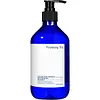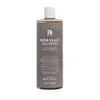What's inside
What's inside
 Key Ingredients
Key Ingredients

 Benefits
Benefits

 Concerns
Concerns

 Ingredients Side-by-side
Ingredients Side-by-side

Water
Skin ConditioningCoco-Betaine
CleansingSodium Surfactin
CleansingSodium Cocoyl Alaninate
Lauryl Glucoside
CleansingDisodium Laureth Sulfosuccinate
CleansingGlycerin
HumectantSodium Chloride
MaskingSodium Lauroyl Methyl Isethionate
CleansingCaprylyl Glycol
EmollientCetyl Alcohol
EmollientHydroxyacetophenone
AntioxidantPolyquaternium-10
Citric Acid
BufferingMenthol
MaskingGuar Hydroxypropyltrimonium Chloride
Skin ConditioningMelaleuca Alternifolia Leaf Oil
AntioxidantPentasodium Pentetate
Citrus Paradisi Peel Oil
MaskingButylene Glycol
HumectantAcorus Calamus Root Extract
PerfumingAllium Cepa Bulb Extract
Skin ConditioningArtemisia Capillaris Extract
Brassica Oleracea Italica Extract
Astringent1,2-Hexanediol
Skin ConditioningCnidium Officinale Root Extract
Skin ConditioningHouttuynia Cordata Extract
Skin ConditioningCysteine
AntioxidantMethionine
Skin ConditioningMelaleuca Alternifolia Leaf Extract
PerfumingSalvia Officinalis Leaf Extract
CleansingCamellia Japonica Flower Extract
EmollientZingiber Officinale Root Extract
MaskingEthylhexylglycerin
Skin ConditioningWater, Coco-Betaine, Sodium Surfactin, Sodium Cocoyl Alaninate, Lauryl Glucoside, Disodium Laureth Sulfosuccinate, Glycerin, Sodium Chloride, Sodium Lauroyl Methyl Isethionate, Caprylyl Glycol, Cetyl Alcohol, Hydroxyacetophenone, Polyquaternium-10, Citric Acid, Menthol, Guar Hydroxypropyltrimonium Chloride, Melaleuca Alternifolia Leaf Oil, Pentasodium Pentetate, Citrus Paradisi Peel Oil, Butylene Glycol, Acorus Calamus Root Extract, Allium Cepa Bulb Extract, Artemisia Capillaris Extract, Brassica Oleracea Italica Extract, 1,2-Hexanediol, Cnidium Officinale Root Extract, Houttuynia Cordata Extract, Cysteine, Methionine, Melaleuca Alternifolia Leaf Extract, Salvia Officinalis Leaf Extract, Camellia Japonica Flower Extract, Zingiber Officinale Root Extract, Ethylhexylglycerin
Water
Skin ConditioningSaccharomyces Cerevisiae Extract
Skin ConditioningDisodium Laureth Sulfosuccinate
CleansingCocamidopropyl Hydroxysultaine
CleansingLauryl Glucoside
CleansingCocamide Mipa
EmulsifyingSodium Cocoyl Isethionate
CleansingLactobacillus/Leaf Ferment Filtrate
Skin ConditioningButylene Glycol
HumectantSodium Chloride
MaskingDipropylene Glycol
HumectantPolyquaternium-10
1,2-Hexanediol
Skin ConditioningGlycerin
HumectantPropolis Extract
Skin ConditioningGlycine Max Seed Extract
Skin ConditioningMalt Extract
Skin ProtectingPhellodendron Amurense Bark Extract
Skin ConditioningDipotassium Glycyrrhizate
HumectantBiotin
AntiseborrhoeicCamellia Sinensis Leaf Extract
AntimicrobialHouttuynia Cordata Extract
Skin ConditioningPerilla Frutescens Leaf Extract
MaskingAvena Sativa Kernel Extract
AbrasiveHydroxyacetophenone
AntioxidantCaffeine
Skin ConditioningMenthol
MaskingCaprylyl Glycol
EmollientPanthenol
Skin ConditioningSalicylic Acid
MaskingCoconut Acid
CleansingCitric Acid
BufferingNiacinamide
SmoothingSodium Isethionate
CleansingEthylhexylglycerin
Skin ConditioningSodium Gluconate
Skin ConditioningArginine
MaskingParfum
MaskingWater, Saccharomyces Cerevisiae Extract, Disodium Laureth Sulfosuccinate, Cocamidopropyl Hydroxysultaine, Lauryl Glucoside, Cocamide Mipa, Sodium Cocoyl Isethionate, Lactobacillus/Leaf Ferment Filtrate, Butylene Glycol, Sodium Chloride, Dipropylene Glycol, Polyquaternium-10, 1,2-Hexanediol, Glycerin, Propolis Extract, Glycine Max Seed Extract, Malt Extract, Phellodendron Amurense Bark Extract, Dipotassium Glycyrrhizate, Biotin, Camellia Sinensis Leaf Extract, Houttuynia Cordata Extract, Perilla Frutescens Leaf Extract, Avena Sativa Kernel Extract, Hydroxyacetophenone, Caffeine, Menthol, Caprylyl Glycol, Panthenol, Salicylic Acid, Coconut Acid, Citric Acid, Niacinamide, Sodium Isethionate, Ethylhexylglycerin, Sodium Gluconate, Arginine, Parfum
Ingredients Explained
These ingredients are found in both products.
Ingredients higher up in an ingredient list are typically present in a larger amount.
1,2-Hexanediol is a synthetic liquid and another multi-functional powerhouse.
It is a:
- Humectant, drawing moisture into the skin
- Emollient, helping to soften skin
- Solvent, dispersing and stabilizing formulas
- Preservative booster, enhancing the antimicrobial activity of other preservatives
Butylene Glycol (or BG) is used within cosmetic products for a few different reasons:
Overall, Butylene Glycol is a safe and well-rounded ingredient that works well with other ingredients.
Though this ingredient works well with most skin types, some people with sensitive skin may experience a reaction such as allergic rashes, closed comedones, or itchiness.
Learn more about Butylene GlycolCaprylyl Glycol is a humectant and emollient, meaning it attracts and preserves moisture.
It is a common ingredient in many products, especially those designed to hydrate skin. The primary benefits are retaining moisture, skin softening, and promoting a healthy skin barrier.
Though Caprylyl Glycol is an alcohol derived from fatty acids, it is not the kind that can dry out skin.
This ingredient is also used as a preservative to extend the life of products. It has slight antimicrobial properties.
Learn more about Caprylyl GlycolCitric Acid is an alpha hydroxy acid (AHA) naturally found in citrus fruits like oranges, lemons, and limes.
Like other AHAs, citric acid can exfoliate skin by breaking down the bonds that hold dead skin cells together. This helps reveal smoother and brighter skin underneath.
However, this exfoliating effect only happens at high concentrations (20%) which can be hard to find in cosmetic products.
Due to this, citric acid is usually included in small amounts as a pH adjuster. This helps keep products slightly more acidic and compatible with skin's natural pH.
In skincare formulas, citric acid can:
While it can provide some skin benefits, research shows lactic acid and glycolic acid are generally more effective and less irritating exfoliants.
Most citric acid used in skincare today is made by fermenting sugars (usually from molasses). This synthetic version is identical to the natural citrus form but easier to stabilize and use in formulations.
Read more about some other popular AHA's here:
Learn more about Citric AcidThis ingredient is a cleansing agent, surfactant, and foam booster. It considered an alternative to traditional sulfates (Sulfosuccinate) and is allowed in "sulfate-free" products.
According to a manufacturer, this ingredient is mild and can be used in baby and bath options.
Ethylhexylglycerin (we can't pronounce this either) is commonly used as a preservative and skin softener. It is derived from glyceryl.
You might see Ethylhexylglycerin often paired with other preservatives such as phenoxyethanol. Ethylhexylglycerin has been found to increase the effectiveness of these other preservatives.
Glycerin is already naturally found in your skin. It helps moisturize and protect your skin.
A study from 2016 found glycerin to be more effective as a humectant than AHAs and hyaluronic acid.
As a humectant, it helps the skin stay hydrated by pulling moisture to your skin. The low molecular weight of glycerin allows it to pull moisture into the deeper layers of your skin.
Hydrated skin improves your skin barrier; Your skin barrier helps protect against irritants and bacteria.
Glycerin has also been found to have antimicrobial and antiviral properties. Due to these properties, glycerin is often used in wound and burn treatments.
In cosmetics, glycerin is usually derived from plants such as soybean or palm. However, it can also be sourced from animals, such as tallow or animal fat.
This ingredient is organic, colorless, odorless, and non-toxic.
Glycerin is the name for this ingredient in American English. British English uses Glycerol/Glycerine.
Learn more about GlycerinHouttuynia Cordata Extract is more commonly known as Heart Leaf, Fish Mint, or Chameleon plant.
The components found in Heart Leaf give it antioxidant, hydrating, antimicrobial, and anti-inflammatory properties.
Heart Leaf is rich in flavonoids such as quercetin, apigenin, and more. It also contains polysaccharides, the most common type of carbs in food.
Flavonoids have been shown to be effective antioxidants. They help neutralize free-radical molecules. Free-radical molecules are unstable molecules that may damage our skin cells and DNA. The flavonoids in Heart Leaf also help soothe the skin.
Polysaccharides are naturally found in our skin. They play a role in hydrating and repairing the top layer of skin. The polysaccharides in Heart Leaf help moisturize our skin.
Studies show decanoyl acetaldehyde, a component of Heart Leaf oil, is effective at killing bacteria.
The name 'Fish Mint' comes from the herb's natural fishy smell. Is is native to southeast Asia and used throughout the continent for traditional cooking and medicine.
Learn more about Houttuynia Cordata ExtractHydroxyacetophenone is antioxidant with skin conditioning and soothing properties. It also boosts the efficiency of preservatives.
This ingredient is not irritating or sensitizing.
Lauryl Glucoside sugar- and lipid-based cleansing agent. It is created from glucose and lauryl alcohol.
This ingredient is a surfactant, making it easier to rinse oil, dirt, and other pollutants away.
A British study found lauryl glucoside to cause skin sensitivity for some people. We recommend speaking with a professional if you have concerns.
Other names for this ingredient include "Lauryl Polyglucose", "Lauryl glycoside", and "D-Glucopyranoside".
Learn more about Lauryl GlucosideMenthol is a compound found in mint plants, such as peppermint. In its pure form, it is a clear crystalline substance.
Menthol is known for its cooling sensation; however, the cooling is actually from your skin being sensitized. Menthol can worsen rosacea. We recommend speaking with a professional if you have concerns.
Menthol also has antimicrobial properties.
Learn more about MentholPolyquaternium-10 is an ammonium salt of hydroxyethylcellulose. It is a white and granular powder used as a film-former and anti-static agent.
This ingredient is commonly found in hair conditioning products. According to a manufacturer, its positive charge makes it great for absorbing hair proteins. The manufacturer also states this ingredient helps with curl retention.
For haircare friends: this ingredient is not a silicone.
Learn more about Polyquaternium-10Chances are, you eat sodium chloride every day. Sodium Chloride is also known as table salt.
This ingredient has many purposes in skincare: thickener, emulsifier, and exfoliator.
You'll most likely find this ingredient in cleansers where it is used to create a gel-like texture. As an emulsifier, it also prevents ingredients from separating.
There is much debate on whether this ingredient is comedogenic. The short answer - comedogenic ratings don't tell the whole story. Learn more about comegodenic ratings here.
The concensus about this ingredient causing acne seems to be divided. Research is needed to understand if this ingredient does cause acne.
Scrubs may use salt as the primary exfoliating ingredient.
Learn more about Sodium ChlorideWater. It's the most common cosmetic ingredient of all. You'll usually see it at the top of ingredient lists, meaning that it makes up the largest part of the product.
So why is it so popular? Water most often acts as a solvent - this means that it helps dissolve other ingredients into the formulation.
You'll also recognize water as that liquid we all need to stay alive. If you see this, drink a glass of water. Stay hydrated!
Learn more about Water